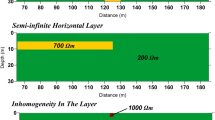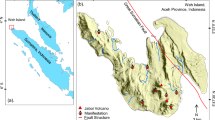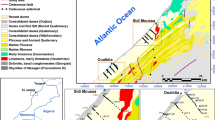Abstract
This paper presents a short theoretical summary of the series expansion-based 2.5D combined geoelectric weighted inversion (CGWI) method and highlights the advantageous way with which the number of unknowns can be decreased due to the simultaneous characteristic of this inversion. 2.5D CGWI is an approximate inversion method for the determination of 3D structures, which uses the joint 2D forward modeling of dip and strike direction data. In the inversion procedure, the Steiner’s most frequent value method is applied to the automatic separation of dip and strike direction data and outliers. The workflow of inversion and its practical application are presented in the study. For conventional vertical electrical sounding (VES) measurements, this method can determine the parameters of complex structures more accurately than the single inversion method. Field data show that the 2.5D CGWI which was developed can determine the optimal location for drilling an exploratory thermal water prospecting well. The novelty of this research is that the measured VES data in dip and strike direction are jointly inverted by the 2.5D CGWI method.
















Similar content being viewed by others
References
Alpin LM, Berdichevskii MN, Vedsintsev GA, Zagarmistr AM (1966) Dipole methods for measuring earth conductivity. (Selected and translated from the Russian by Keller G.V.), Consultant Bureau, New York
Auken E, Christiansen AV (2004) Layered and laterally constrained 2D inversion of resistivity data. Geophysics 69:752–761
Auken E, Chrisiansen AV, Jacobsen BH, Foged N, Sorensen KI (2005) Piecewise 1D laterally constrained inversion of resistivity data. Geophys Prospect 53:497–506
Barker RD (1992) A simple algorithm for electrical imaging of the surface. First Break 10:53–62
Beard LP, Morgan FD (1991) Assessment of 2D resistivity structures using 1D inversion. Geophysics 56:874–883
Blaschek R, Hördt A, Kemna A (2008) A new sensitivity-controlled focusing regularization scheme for the inversion of induced polarization data based on the minimum gradient support. Geophysics 73:45–54
Bortoloza CA, Porsani ER, Almeida ER, Santos FAM (2011) 1D joint inversion of DC and TEM data for hydrogeological applications. In: Near surface 17th EAGE European meeting of environmental and engineering geophysics
Buvat S, Schamper C, Tabbagh A (2013) Approximate Threedimensional resistivity modelling using Fourier analysis of layer resistivity in shallow soil studies. Geophys J Int 194:158–169
Coggon JA (1971) Electromagnetic and electrical modeling by the finite-element method. Geophysics 36:132–155
Dey A, Morrison HF (1979a) Resistivity modelling for arbitrarily shaped two dimensional structures. Geophys Prospect 27:106–136
Dey A, Morrison HF (1979b) Resistivity modelling for arbitrarily shaped three dimensional structures. Geophysics 44:753–780
Dobróka M, Szabó PN (2005) Combined global/linear inversion of well-logging data in layer-wise homogeneous and inhomogeneous media. Acta Geod et Geophys Hung 40(2):203–214
Dobróka M, Völgyesi L (2008) Inversion reconstruction of gravity potential based on gravity gradients. Math Geosci 40(3):299–311
Dobróka M, Gyulai Á, Ormos T, Csókás J, Dresen L (1991) Joint inversion of seismic and geoelectric data recorded in an underground coal mine. Geophys Prospect 39:643–655
Dobróka M, Szabó PN, Cardarelli E, Vass P (2009) 2D inversion of borehole logging data for simultaneous determination of rock interfaces and petrophysical parameters. Acta Geod et Geophys Hung 44(4):459–479
Dobróka M, Szabó NP, Tóth J, Vass P (2016) Interval inversion approach for an improved interpretation of well logs. Geophysics 81(2):D163–D175
Doetsch J, Linde N, Coscia S, Greenhalgh SA, Green AG (2010) Zonation for 3D aquifer characterisation based on joint inversion of multimethod crosshole geophysical data. Geophysics 75(6):53–64
Drahos D (2008) Determining the objective function for geophysical joint inversion. Geophys Trans 45:105–121
Gallardo LA, Meju MA (2004) Joint two dimensional DC resistivity and seismic travel-time inversion with cross-gradients constraints. J Geophys Res 109(B3):3311–3321
Gandomi JA, Binley A (2013) A Bayesian Transdimensional approach for the fusion of multiple geophysical dataset. J Appl Geophys 96:38–54
Geotomo Software (2006) Res2DINV ver. 3.55 Malaysia. www.geoelectrical.com
Günter T, Rücker C, Spitzer K (2006) Three-dimensional modelling and inversion of dc resistivity data incorporating topography-II. Inversion. Geophys J Int 166(2):506–517. doi:10.1111/j.1365-246X.2006.03011.x
Gyulai Á, Ormos T (1996) Simultaneous inversion of geoelectric data for dipping beds based an analytical forward modelling (in hungarian). Magy Geofiz 37:17–26
Gyulai Á, Ormos T (1999) A new procedure for the interpretation of VES data: 1.5 D simultaneous inversion method. J Appl Geophys 41:1–17
Gyulai Á, Szabó NP (2014) Geoenvironmental investigation by series expansion based geoelectric inversion methodology. Front in Geosci 2(1):11–17
Gyulai Á, Tolnai ÉE (2012) 2.5D geoelectric inversion method using series expansion. Acta Geod et Geophys Hung 47(2):210–222
Gyulai Á, Ormos T, Dobróka M (2010) A quick 2D geoelectric inversion method using series expansion. J Appl Geophys 72(4):232–241
Gyulai Á, Turai E, Baracza MK (2012) The analysis of CGWI inversion results involving a field case (in Hungarian). Magy Geofiz 53(4):264–274
Gyulai Á, Baracza MK, Tolnai ÉE (2013) The application of joint inversion in geophysical exploration. Int J Geosci 4:283–289
Gyulai Á, Baracza MK, Szabó NP (2014) On the application of combined geoelectric weighted inversion in environmental exploration. Environ Earth Sci 71:383–392
Haber E, Oldenburg DW (1997) Joint inversion: a structural approach. Inverse Probl 13(1):63–77
Hering A, Misiek R, Gyulai Á, Ormos T, Dobróka M, Dresen L (1995) A joint inversion algorithm to process geoelectric and surface wave seismic data. Part I. Basic ideas. Geophys Prospect 43:135–156
Jegen M, Hobbs RW, Tartis P, Chave A (2009) Joint inversion of marine magnetotelluric and gravity data incorporating seismic constraints. Preliminary results of sub basalt imaging of the Farve Shelf. Earth Planet Sci Lett 282(1–4):47–95
Kis M, Gyulai Á, Ormos T, Dobróka M, Dresen L (1998) A new approach for the investigation of 2D structures-method development and case-history. In: 60th EAGE conference and technical exhibition, 8–12 June 1998
Kiss G (2007) The Zemplén-mountain protected area, the mountain’s name, boundaries and landscapes (in hungarian). Bükk Publisher, Eger, pp 9–12
Koefoed O, Mallick K (1979) Geosounding principles 1, resistivity sounding measurements. Elsevier, Amsterdam
Kumar R, Das UC (1978) Transformation of Schlumberger apparent resistivity to dipole apparent resistivity over layered earth by the application of digital linear filters. Geophys Prospect 26:352–358
Lee T (1975) An integral equation and its solution for some two- and three-dimensional problems in resistivity and induced polarisation. Geophysics 42:81–95
Li Y, Oldenburg DW (1994) Inversion of 3D DC resistivity data using an approximate inverse mapping. Geophys J Int 116:527–537
Loke MH, Barker RD (1996) Rapid least-squares inversion of apparent resistivity pseudosections by a quasi-Newton method. Geophys Prospect 44:131–152
Meheni Y, Guerin R, Benderitter Y, Tabbagh A (1996) Surface DC resistivity mapping: approximate 1D interpretation. J Appl Geophys 34:255–270
Menke W (1984) Geophysical data analysis—discrete inverse theory. Academic Press, London
Misiek R, Liebig A, Gyulai Á, Ormos T, Dobróka M, Dresen L (1997) A joint inversion algorithm to process geoelectric and surface wave seismic data. Part II. Application. Geophys Prospect 45:65–85
Mufti IR (1976) Finite difference resistivity modelling for arbitrarily shaped two-dimensional structures. Geophysics 46:1148–1163
Olainka AI, Weller A (1997) The inversion of geoelectrical data for hydrogeological application in crystalline basement areas of Nigeria. J Appl Geophys 37:103–115
Sasaki Y (1994) 3D resistivity inversion using the finite-element method. Geophysics 57:1270–1281
Spitzer K (1995) A 3D finite difference algorithm for DC resistivity modelling using conjugate gradient methods. Geophys J Int 123:902–914
Steiner F (1988) Most frequent value procedures. (short monograph). Geophys Trans 34:139–260
Steiner F (1991) The most frequent value. Introduction to a modern conception of statistics. Academic Press, Budapest. ISBN 9630556871
Steiner F (1997) Optimum methods in statistics (English). Akadémiai Kiadó, Budapest. ISBN 963057439X
Szabó NP (2004) Global inversion of well log data. Geophysical Transactions, vol 44, no 3–4, pp 313–329, HU ISSN 0016-7177
Szabó NP (2015) Hydraulic conductivity explored by factor analysis of borehole geophysical data. Hydrogeol J (online first article). doi:10.1007/s10040-015-1235-4
Szabó NP, Balogh GP (2016) Most frequent value based factor analysis of engineering geophysical sounding logs. In: 78th EAGE conference and exhibition 30 May–2 June 2016, paper: Tu SBT412
Székely F, Szűcs P, Zákányi B, Cserny T, Fejes Z (2015) Comparative analysis of pumping tests conducted in layered rhyolitic volcanic formations. J Hydrol 520:180–185
Szűcs P, Fejes Z, Szlabóczky P (2013) Hydrogeophysical research in the southern part of the Tokaj mountains (in Hungarian). Technical sciences of the north-east region in Hungary Debrecen, technical professional committee of academic committee of Debrecen, electronic technical papers XII, pp 66–73
Tripp AC, Holmann GW, Swift CM (1984) Two-dimensional resistivity inversion. Geophysics 49:1708–1717
Vozoff K, Jupp DLB (1975) Joint inversion of geophysical data. Geophys J R Astron Soc 42:977–991
Acknowledgements
The research was supported by the GINOP-2.3.2-15-2016-00010 “Development of enhanced engineering methods with the aim at utilization of subterranean energy resources” project in the framework of the Széchenyi 2020 Plan, funded by the European Union, co-financed by the European Structural and Investment Funds. The research was partly supported by the Hungarian Research Fund OTKA (Project No. K109441). As participant researcher of the OTKA project, the first author is grateful for the support.
Author information
Authors and Affiliations
Corresponding author
Appendix
Appendix
For further interpretation of the depth analysis discussed in Sect. 3.2.2, Figs. 17 and 18 show more information. Figure 17 represents the relations between the depth estimation errors, while Fig. 18 shows the relations between the errors of depth parameter estimation. Both figures show that despite the high deviation between the depths and errors estimated by single 1D, 2D CGI (dip), 2D CGI (strike) and 2.5D CGWI procedures, there is a strong correlation between them, as shown by the high correlation coefficients (r). The deviation in regression coefficients in Fig. 18 is calculated by
where sq′d means the residual mean square of the layer thicknesses H (H = h 1 + h 2 + h 3 + h 4), i is the number of layers and n is the number of VES stations. (The above quantity is not the same as the estimation error of inversion-derived model parameters.) Not only relations between the depths but also those of the estimation errors are determined for the 2D dip and 2D CGI procedures using VES data measured along dip direction. There is an outstanding relation between the errors characterizing the quality of depth estimation of the inversion methods. The errors are listed in Table 3 (Sect. 3.2.2). A linear relation between the results of 2.5D CGWI and other inversion methods is observable here. For a better representation, the values were plotted on a logarithmic scale on the ordinate axis, which may bias the linear trend between the relevant variables. Values r (r = 0.76; 0.54; 0.82) refer to a function-like relationship (Fig. 17). We emphasize here the reliability of the estimation results of 2.5D CGWI, even when this approximation causes considerable bias.
Rights and permissions
About this article
Cite this article
Gyulai, Á., Szűcs, P., Turai, E. et al. Geoelectric Characterization of Thermal Water Aquifers Using 2.5D Inversion of VES Measurements. Surv Geophys 38, 503–526 (2017). https://doi.org/10.1007/s10712-016-9393-z
Received:
Accepted:
Published:
Issue Date:
DOI: https://doi.org/10.1007/s10712-016-9393-z






